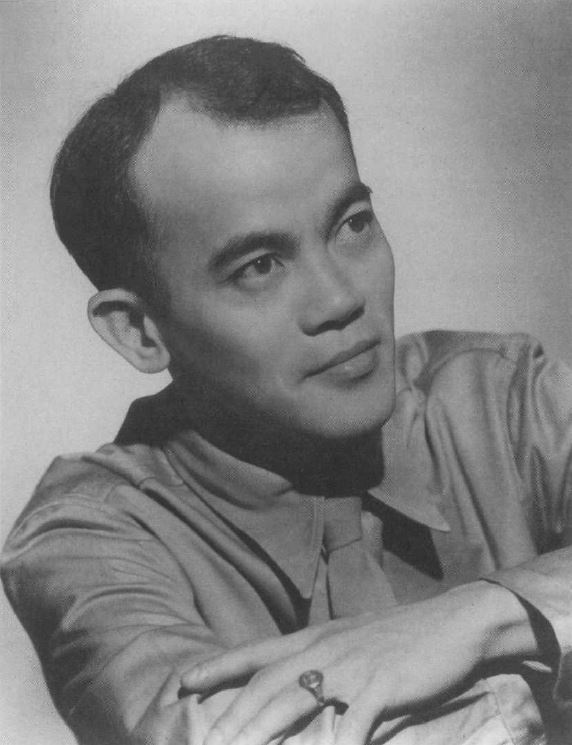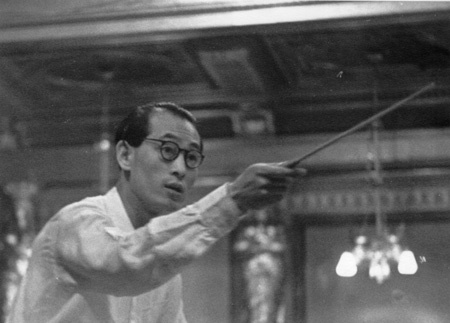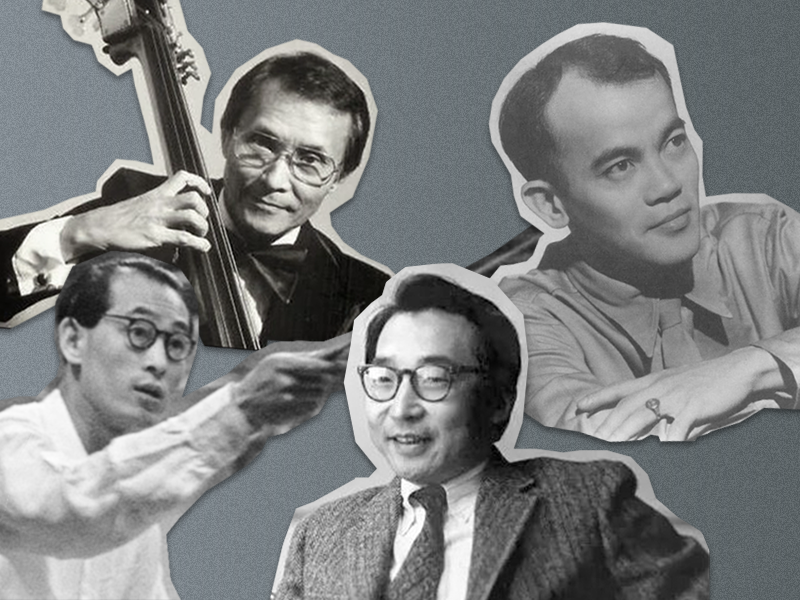Asian American Pacific Islander Heritage in the Fleisher Collection
By Fleisher CollectionThe Edwin A. Fleisher Collection of Orchestral Music at the Free Library of Philadelphia offers a closing theme as Asian American and Pacific Islander Heritage Month comes to an end for 2023.
As we share a sampling of the rich cultural treasures from 59 Asian Pacific composers represented in our special collection, we endeavor to inspire curiosity and hope you will further explore these composers, their peers, and their art throughout our branches. We also take this opportunity to encourage our symphonic patrons to prepare programming for the 2023-2024 concert season with an eye toward next May and an ear open for the many cultural treasures in the Fleisher Collection. With this simple mission in mind, we offer just a few of our favorites.

Chou Wen-chung (1923-2019)
In December 2021, we featured "And the Fallen Petals" (1954) by Chinese composer Chou Wen-chung on Fleisher Discoveries (available on Soundcloud and Spotify). The Koussevitzky Foundation sponsored this particular 1959 performance by the San Francisco Symphony conducted by Enrique Jordá as part of the American International Music Fund (AIMF). The Fleisher Collection digitized this specific recording in 2020 from a 7” reel-to-reel tape — one of only seven produced — housed in our archives.
Notably, it was former Philadelphia Orchestra music director Leopold Stokowski who had essentially launched Chou’s career in 1953 with the premiere of "Landscapes" also, coincidentally, with the San Francisco Symphony.

Lee Dai-Keong (1915-2005)
Dai-Keong Lee was the first Hawaiian-born composer to play a significant role in American orchestral composition. His music enjoyed significant representation with major orchestras across the nation, and musically, his use of Hawaiian and other regional elements in compositions broadened the panorama of American music in the concert hall.
Born in Honolulu, Lee studied piano, trumpet, French horn, and Western music in his youth. In 1933, Lee enrolled at the University of Hawaii to study medicine. As a medical student, however, Lee remained active in orchestral composition and even published an article on Chinese instruments in the February 1935 issue of Etude. Fritz Hart, the conductor of the Honolulu Symphony, encouraged Lee's musical endeavors and premiered one of his early works, "Valse Penseroso," at the Academy of Arts in 1936. The following year, Lee abandoned his plans for a career in medicine when he was awarded a fellowship to the Juilliard School of Music in New York.
Lee would study music with several iconic American composers, including Roger Sessions and Aaron Copland, before enlisting in the US Army Fifth Air Force Signal Corps and serving in the South Pacific during World War II. Lee conducted the Australian Broadcasting Company Symphony Orchestra in the two completed movements from his "First Symphony," a modal neoclassical work, while on furlough in Sydney, and his continued musical efforts were documented in a December 1943 issue of the Army publication Yank. After the war, Lee completed his three-movement "First Symphony," which Howard Hanson conducted with the Eastman-Rochester Symphony Orchestra. His "Symphony No. 2" was runner-up for the 1952 Pulitzer Prize for Music.
Symphony No. 1 I. Adagio con anima
Symphony No. 1 II. Andante espressivo
Symphony No. 1 III. Allegro animato

Ángel Matias Peña (1921-2014)
Born into a musical family, his career choice seems inevitable. Peña played bass and wrote jazz and kundiman — nationalist Filipino songs disguised as love songs — as well as classical works. Largely self-taught, Peña grew up in Malabon, which was famous for its musicians and marching bands and he devoured books on music theory despite his father’s encouragement that he take up a respectable non-musical profession.
Peña’s symphonic poem, "Igorot Rhapsody" (1959), took first prize in a composition competition at the University of Santo Tomas Conservatory of Music, where it would premiere under Bernardino Custodio. The Igorot, indigenous peoples of the Cordillera Mountain Range in the northern Philippines, staunchly and successfully fought Christianization and Spanish colonization throughout the 17th century. As a result, they have maintained many traditional religious and cultural practices well into the 21st century.
Peña wrote in the foreword to the published score for "Igorot Rhapsody,"
“In employing native thematic materials in a symphonic work such as this, I was motivated by a sincere desire to preserve, in my own small way, what little is left of our fast-disappearing aboriginal music. These themes have an inherent beauty which imparts a truly distinctive aura of the Philippines to the composition, thus reflecting a native culture that should clearly identify our people."
Performance by Philippine Philharmonic Orchestra, Ruggero Barbieri conducting

Ahn Eak-tai (1906-1965)
Born in Pyongyang (the present-day capital of North Korea), Ahn studied violin and trumpet before taking up cello in the school orchestras. Under Japanese rule, he became active in the Korean independence movement, yet would complete studies in Tokyo. Social restrictions on Korean nationals ultimately led him to the United States, where he became the first cellist in the Cincinnati Symphony Orchestra and enrolled in the University of Cincinnati Conservatory of Music. With aspirations to become a conductor, Ahn transferred to the Curtis Institute in Philadelphia in 1935, worked with Edwin Fleisher’s Symphony Club, and graduated from Curtis the following year.
After graduation, Ahn headed to Europe where he studied with Zoltán Kodály in Hungary. Kodály’s focus on the importance of folk traditions inspired Ahn’s composition, "Korea," a symphonic tone poem that included strains of Korea’s national anthem (newly composed by Ahn). Ahn would add the finishing touches to his work under Richard Strauss, and conduct his work in Dublin in 1937. While Irish nationals under British rule empathized with Ahn’s work, the Japanese government did not approve.
The Orquesta de Cámara Millenium, Jae-sik Kim conducting
Ahn’s studies with Strauss afforded the young conductor opportunities to conduct the Berlin Philharmonic Orchestra and serve as assistant conductor during Strauss Festivals. Ahn’s stellar career would have him wave the baton before orchestras in Berlin, Bucharest, Budapest, Mallorca, Mexico City, New York, Paris, and Vienna and work with distinguished soloists such as Alfred Cortot and Emil Sauer.
In 1948, Korea adopted Ahn’s musical accompaniment for the national anthem, "Aegukga," to replace the Scottish tune, "Auld Lang Syne," to which it was previously sung, and a military band performed it for Ahn’s return to Korea in 1955 at the invitation of President Syngman Rhee.
Visit the Fleisher Discoveries Spotify channel for a curated list of musical treasures from composers sharing Asian American and Pacific Islander heritage!
Have a question for Free Library staff? Please submit it to our Ask a Librarian page and receive a response within two business days.

